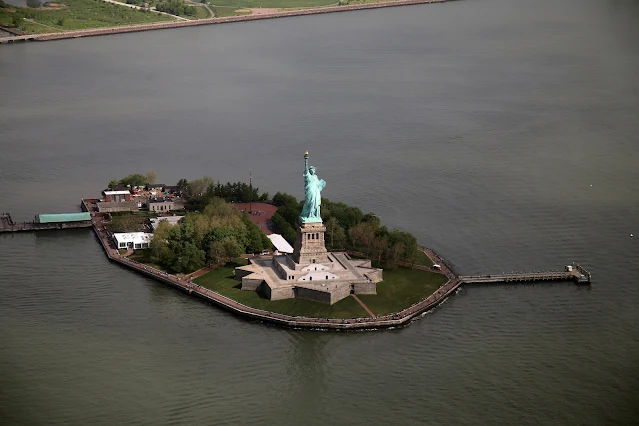The Colossus That Came to Symbolize a Nation
It rises from the water like a myth made manifest—arm outstretched, torch aloft, gaze fixed beyond the horizon. The Statue of Liberty is more than a landmark. It is a promise carved in copper. Since her arrival in New York Harbor in 1886, she has greeted millions, becoming both a literal and symbolic beacon for those seeking freedom. But behind the image immortalized on postcards and souvenirs stands a visionary sculptor whose ambition was as monumental as the statue itself: Frédéric Auguste Bartholdi.
Bartholdi’s creation, blending engineering and art, nationalism and idealism, stands not just as a gift from France to the United States, but as one of the most iconic public artworks in history. The story of Lady Liberty is also the story of Bartholdi’s tenacity, vision, and unwavering belief in liberty.
Early Life: From Alsace to Ambition
Frédéric Auguste Bartholdi was born in 1834 in Colmar, a town in the Alsace region of France. His father died when he was young, and Bartholdi was raised by a strong-willed mother who encouraged his creative instincts. He studied painting and architecture in Paris, but it was sculpture that captured his imagination. Even early in his career, Bartholdi favored grand scale, seeking inspiration from ancient colossi like the Great Sphinx and the Colossus of Rhodes.
Bartholdi was shaped not only by artistic influences but also by political upheavals. The Franco-Prussian War left Alsace under German control, an event that deeply wounded the proud Alsatian. His national pride would later find expression in his monumental works, particularly the Statue of Liberty—a gesture of Franco-American solidarity and shared democratic ideals.
Artistic Vision: A Language of Monumentality
Bartholdi’s art was defined by scale and symbolism. He believed that public sculpture should do more than decorate—it should inspire. “I have a horror of sculptors who merely copy,” he once said. His work was not delicate, intricate ornamentation; it was architectural in nature, intended to last for centuries, to speak across generations.
With the Statue of Liberty, Bartholdi aimed to synthesize form and message. The figure is modeled on Libertas, the Roman goddess of liberty, but she is imbued with a modern republican spirit. Her face was said to be inspired by Bartholdi’s own mother—a personal gesture buried in global symbolism. The torch she holds high represents enlightenment; the broken chains at her feet, emancipation. Every aspect was intentional, a sculptural thesis on freedom.
Liberty Enlightening the World: A Colossal Undertaking
Commissioned in the 1870s, the project was officially titled La Liberté éclairant le monde—Liberty Enlightening the World. Bartholdi envisioned the statue as a gift from the people of France to the United States, honoring the centennial of American independence and reinforcing the democratic alliance between the two nations.
Constructing the statue was an engineering and artistic marvel. Gustave Eiffel, the same engineer behind the Eiffel Tower, designed the internal iron skeleton that allowed the copper skin to move slightly with the wind and temperature changes—ensuring its survival for centuries. The statue was constructed in France, then disassembled, shipped across the Atlantic in crates, and reassembled on what would become Liberty Island.
When it was unveiled in 1886, the Statue of Liberty was the tallest structure in New York City. It wasn’t just a technical triumph; it was a political one. As historian Edward Berenson noted, “Liberty became the most powerful image of democracy not only in the U.S. but around the world.”
Legacy: A Sculptor Who Built Ideals in Metal
Bartholdi did not live to see the full extent of his statue’s cultural power. He died in 1904, just as Lady Liberty was becoming a permanent fixture of the American imagination. But even in his lifetime, he witnessed the resonance of his work. The statue quickly became a rallying point for immigrants arriving in the United States, symbolizing hope and opportunity.
The statue has since become embedded in literature, politics, protest, and pop culture. From Emma Lazarus’s sonnet “The New Colossus,” engraved at its base, to its appearance in countless films and artworks, the Statue of Liberty transcended its origins. It became not only a symbol of America but a global icon of freedom.
Bartholdi’s influence also extended into debates about public art and national identity. His colossal realism paved the way for modern memorial architecture, echoing in later works like Mount Rushmore or even Maya Lin’s Vietnam Veterans Memorial in its blend of monumentality and message.
In the art market, Bartholdi’s smaller works—bronze maquettes, models, and busts—have gained value over time, often fetching significant prices at auction. But his true masterpiece cannot be bought or sold; it towers in New York Harbor, where millions still look up and feel seen.
Conclusion: Liberty in Form, Freedom in Meaning
Bartholdi’s Statue of Liberty endures not just because of its craftsmanship or engineering genius, but because it offers a vision of freedom rendered in form. It’s an artwork that belongs to everyone—not locked behind museum walls, but out in the elements, weathering the decades alongside the people it was made to welcome.
To explore Bartholdi’s work is to confront the question of what liberty really means—and to realize that the best public art is not only beautiful, but also deeply human. As long as there are those searching for light in darkness, Bartholdi’s flame will remain lit.
Keywords:
Statue of Liberty history, Bartholdi sculptor biography, Liberty Enlightening the World, Statue of Liberty symbolism, French-American art, public art history, Bartholdi and Eiffel, 19th-century sculpture, Colmar artist, Statue of Liberty cultural legacy



.jpg)
Comments
Post a Comment